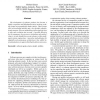516 search results - page 18 / 104 » Modeling the IT Impact on Organizational Structure |
WETICE
1998
IEEE
13 years 11 months ago
1998
IEEE
The development of software products has become a highly cooperative and distributed activity involving working groups at geographically distinct places. These groups show an incr...
CONTEXT
2007
Springer
14 years 1 months ago
2007
Springer
The ability to model cognitive agents depends crucially on being able to encode and infer with contextual information at many levels (such as situational, psychological, social, or...
GFKL
2004
Springer
14 years 28 days ago
2004
Springer
A hierarchical extension of the finite mixture model is presented that can be used for the analysis of nested data structures. The model permits a simultaneous model-based cluster...
ISWC
2003
IEEE
14 years 24 days ago
2003
IEEE
Knowledge of how people interact is important in many disciplines, e.g. organizational behavior, social network analysis, information diffusion and knowledge management applicatio...
DSOM
2008
Springer
13 years 9 months ago
2008
Springer
Incident Management is the process through which IT support organizations manage to restore normal service operation after a service disruption. The complexity of IT support organi...

